Augmented Reality Healthcare Innovations Impact
Augmented reality healthcare innovations impact is transforming the healthcare landscape, offering exciting possibilities for improved patient care and enhanced professional capabilities. From personalized experiences to streamlined workflows, AR is reshaping how we approach diagnostics, surgery, and patient education. The technology promises to enhance the patient journey, empower healthcare professionals, and optimize resource allocation, all while presenting intriguing ethical considerations and future trends.
This exploration delves into the multifaceted impact of augmented reality in healthcare, examining its applications across various disciplines, the potential benefits and challenges, and the exciting possibilities for the future of patient care.
Augmented Reality in Healthcare
Augmented reality (AR) is rapidly transforming healthcare by overlaying digital information onto the real world, enhancing the experiences and workflows of healthcare professionals. This technology has the potential to improve patient care, streamline procedures, and foster a more efficient and informed healthcare system.AR in healthcare leverages the power of computer vision, spatial mapping, and interactive interfaces to provide clinicians with real-time information and tools, directly integrated into their daily practice.
This allows for enhanced visualization, improved decision-making, and more effective treatment strategies.
Fundamental Technologies Enabling AR Healthcare
The core technologies driving AR healthcare applications include:
- Computer Vision: This technology allows AR devices to interpret and understand the physical environment, enabling accurate overlay of digital information onto real-world objects and scenes. For instance, computer vision algorithms can identify anatomical structures during surgery or locate specific patient data in a hospital room.
- Spatial Mapping: AR applications rely on spatial mapping to create a digital representation of the physical space. This enables the accurate placement of virtual objects within the environment. For example, during surgery, AR overlays can be precisely positioned on anatomical structures based on a real-time spatial map of the surgical field.
- Interactive Interfaces: These interfaces, typically through head-mounted displays or smartphones, provide users with intuitive ways to interact with the AR overlay. For example, surgeons can use touch-based controls or voice commands to manipulate virtual tools and data in real-time.
Types of AR Interfaces in Healthcare
AR interfaces in healthcare vary, each designed for specific tasks and user needs. They range from simple smartphone overlays to sophisticated head-mounted displays (HMDs).
- Smartphone-based AR: Utilizing readily available smartphones, these applications often provide basic augmented overlays for clinical decision support, educational tools, and patient-facing information. This approach is cost-effective and accessible for a wide range of settings.
- Head-mounted Displays (HMDs): HMDs offer a more immersive experience, allowing for a more comprehensive view of the overlaid information. These are particularly beneficial in procedures like surgery, where precise guidance and real-time data are crucial. For example, HMDs can provide surgeons with 3D anatomical models overlaid onto the surgical field, guiding their actions.
- Projectors and Markers: AR systems employing projectors and markers project digital information onto physical surfaces, allowing for a hands-on, interactive experience. For example, this approach can be used in training simulations or for patient education, where visual aids are essential.
Potential Applications of AR in Healthcare Disciplines
AR holds promise across numerous healthcare disciplines, offering enhanced capabilities and improved workflows.
- Surgery: AR can guide surgeons during complex procedures by overlaying anatomical models, patient data, and real-time imaging onto the surgical field. This improves precision, reduces invasiveness, and potentially shortens recovery times. One example involves AR-guided surgical procedures for minimally invasive cancer removal, where precision is crucial.
- Diagnostics: AR can aid in diagnosis by providing real-time overlays of anatomical structures and medical images, enhancing the accuracy of interpretation and enabling faster identification of anomalies. A specific example involves using AR to analyze CT scans for potential fractures, helping radiologists identify the extent of damage.
- Training and Education: AR provides interactive simulations and training tools, enabling healthcare professionals to practice procedures in a safe and controlled environment. This allows for continuous improvement and enhanced skill development. For instance, medical students can practice surgical techniques in a virtual environment using AR before performing them on patients.
- Patient Care: AR applications can improve patient engagement and understanding of their conditions through interactive explanations and visualizations. This approach can improve adherence to treatment plans and provide a more patient-centered approach to healthcare. Examples include AR applications that visualize the effects of a specific treatment or explain a complex medical condition.
Impact on Patient Care and Experience
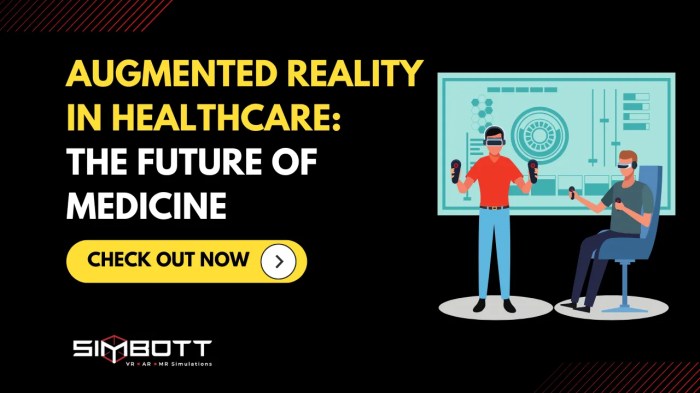
Source: simbott.com
Augmented reality (AR) is rapidly transforming various aspects of healthcare, and its impact on patient care and experience is particularly significant. AR offers the potential to enhance patient engagement, personalize treatment plans, and empower patients to take an active role in their health management. This improved engagement can lead to better treatment outcomes and a more positive patient journey.AR applications in healthcare provide interactive and immersive experiences that can significantly improve patient understanding of their conditions, treatment plans, and overall health journey.
By bridging the gap between complex medical information and patient comprehension, AR has the potential to empower patients and foster a stronger partnership between patients and healthcare providers.
Patient Engagement and Understanding
AR applications can effectively improve patient engagement and understanding by presenting complex medical information in an accessible and interactive format. For example, 3D models of anatomical structures can aid patients in visualizing their conditions, making it easier to grasp the location and nature of a disease or injury. This visual representation can significantly reduce anxiety and improve patient understanding, ultimately promoting better adherence to treatment plans.
Personalization of the Patient Experience
AR enables the personalization of the patient experience by tailoring information and support to individual needs and preferences. This is achieved through the use of interactive tools, personalized 3D models, and customized educational materials. For instance, a patient with a specific injury or disease could receive AR-generated content outlining their particular treatment plan, tailored exercises, and progress tracking, making the experience uniquely relevant to their situation.
This personalized approach fosters a sense of ownership and empowerment, improving the overall patient experience.
AR Tools for Self-Management
AR tools can greatly assist patients in self-managing their health by providing accessible and interactive resources for monitoring and tracking their conditions. These tools can be used to guide patients through exercises, track medication adherence, and provide reminders for appointments. For instance, a patient with diabetes can use an AR application to visualize their blood sugar levels over time, track their insulin intake, and receive personalized recommendations for lifestyle adjustments, enabling them to actively participate in their health management.
Comparison of Patient Experiences with and without AR
The patient experience with AR interventions differs significantly from traditional methods. Without AR, patients may struggle to comprehend complex medical information, potentially leading to anxiety and a decreased understanding of their conditions. Traditional methods often rely on static images or text-based explanations, which can be less engaging and effective for comprehension. Conversely, AR interventions offer interactive and immersive experiences that make complex medical information accessible and understandable, improving patient engagement and fostering a stronger partnership between patient and provider.
AR empowers patients to actively participate in their care, fostering a sense of control and ownership, which ultimately leads to improved treatment outcomes.
Impact on Healthcare Professionals: Augmented Reality Healthcare Innovations Impact
Augmented reality (AR) is rapidly transforming various sectors, and healthcare is no exception. AR’s potential to enhance diagnostic accuracy, streamline surgical procedures, and improve overall workflow efficiency presents significant benefits for healthcare professionals. This section will delve into the specific ways AR is impacting healthcare practitioners.AR applications in healthcare are not just theoretical; they are actively improving the daily experiences of doctors, surgeons, and other medical professionals.
From enhanced diagnostic tools to streamlined surgical procedures, AR is reshaping the way healthcare is delivered.
Enhanced Diagnostic Capabilities
AR overlays digital information onto the real world, enabling healthcare professionals to visualize anatomical structures and medical data simultaneously. This capability is proving invaluable in diagnostics. For example, radiologists can use AR to superimpose 3D models of organs onto X-rays or CT scans, facilitating precise identification of anomalies and improving diagnostic accuracy. The ability to rotate and manipulate these models in real-time provides a richer understanding of the pathology.
Furthermore, AR can integrate patient data, such as medical history and previous imaging results, into the visual representation, enhancing the diagnostic process.
Facilitating Surgical Procedures and Training
AR has the potential to revolutionize surgical procedures by providing surgeons with real-time, interactive guidance during operations. Surgical navigation systems, augmented with AR, can overlay 3D models of the patient’s anatomy onto the surgical field. This allows surgeons to visualize the target area with unprecedented precision, reducing the risk of complications. Furthermore, AR can be used to create immersive surgical training environments, allowing surgeons and other healthcare professionals to practice complex procedures in a safe and controlled setting.
Realistic simulations of surgical scenarios, coupled with immediate feedback, improve surgical proficiency and reduce the learning curve.
Improved Efficiency of Healthcare Workflows
AR applications can streamline workflows in hospitals and clinics by automating tasks, improving communication, and enhancing data management. For instance, AR can assist with medication dispensing by providing real-time instructions, reducing errors and improving efficiency. In addition, AR can be utilized for inventory management, allowing staff to quickly locate and track medical supplies, ensuring that essential items are readily available.
By streamlining these tasks, AR contributes to a more efficient and patient-centric healthcare environment.
Role in Remote Patient Monitoring
AR can play a significant role in remote patient monitoring, enabling healthcare professionals to remotely assess and manage patients’ health conditions. AR-based tools can assist in assessing vital signs, such as heart rate and blood pressure, and provide remote feedback to patients and their care teams. This is particularly helpful for patients with chronic conditions who require ongoing monitoring.
Through AR, healthcare providers can provide timely interventions and improve patient outcomes. Remote monitoring, combined with AR’s capabilities, is expected to revolutionize the future of telehealth and remote care.
Impact on Healthcare Costs and Efficiency
Augmented reality (AR) presents a compelling opportunity to reshape healthcare delivery, potentially leading to significant cost reductions and enhanced efficiency. By overlaying digital information onto the real world, AR can streamline various processes, from surgical procedures to administrative tasks, thereby impacting the bottom line and improving patient outcomes.
Cost Reduction in Healthcare Through AR
AR technologies can reduce healthcare costs by optimizing resource allocation and minimizing procedural errors. By providing real-time guidance and data visualization, AR can potentially reduce the need for costly follow-up procedures and unnecessary hospital readmissions. These cost savings are demonstrably realized in diverse healthcare settings, ranging from operating rooms to outpatient clinics.
Improving Efficiency in Healthcare Delivery with AR
AR facilitates improved efficiency in healthcare delivery by enhancing the accuracy and speed of various tasks. Streamlining workflows and reducing human error can contribute to a more efficient and cost-effective healthcare system. The implementation of AR in administrative tasks further exemplifies this enhanced efficiency.
Potential Cost Savings in Various Healthcare Settings
AR’s potential for cost savings spans numerous healthcare settings. In surgical procedures, AR overlays anatomical data onto the patient, potentially reducing surgical time and minimizing complications. This reduction in operative time translates to cost savings for the hospital. Similarly, in diagnostic settings, AR can assist in accurate and faster diagnoses, reducing the time required for tests and potentially avoiding costly errors.
Further cost savings can be realized in pharmaceutical development through the use of AR simulations for drug interactions and efficacy studies. In patient education, AR can deliver personalized and engaging content, reducing the need for expensive one-on-one consultations.
AR Streamlining Administrative Tasks
AR can streamline administrative tasks by automating and improving data entry and management processes. For instance, AR-guided medication dispensing systems can significantly reduce errors associated with manual medication administration. This reduction in errors directly impacts costs associated with patient care and hospital administration. Moreover, AR can enhance patient record management, enabling faster access to critical information and reducing the time spent on searching and retrieving records.
This efficiency translates to significant cost savings by reducing administrative overhead and improving staff productivity. AR applications in scheduling appointments, tracking equipment, and managing inventory can further contribute to overall operational efficiency.
Examples of AR Applications in Streamlining Tasks
A notable example of AR streamlining tasks is its use in surgical navigation. AR overlays patient-specific anatomical data onto the surgical field, enabling surgeons to precisely locate structures and perform procedures with enhanced precision. This precise navigation can minimize complications, reducing the need for revisions or follow-up procedures, which leads to significant cost savings. Furthermore, AR-guided drug dispensing systems, by minimizing errors in medication administration, can reduce hospital readmissions and associated costs.
These examples showcase the potential of AR to revolutionize healthcare delivery and significantly impact costs.
Ethical Considerations and Challenges
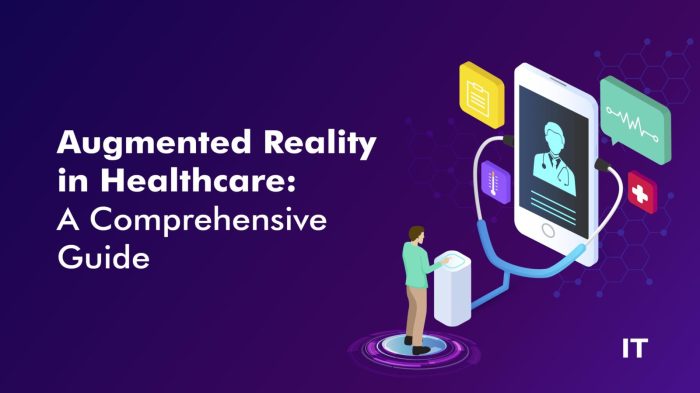
Source: itdigest.com
Augmented reality (AR) in healthcare presents exciting opportunities, but its implementation also raises critical ethical considerations. Careful attention to privacy, security, and data protection is paramount to ensure responsible and equitable use of this technology. Addressing these concerns is crucial for building trust and maximizing the benefits of AR while mitigating potential harms.The rapid advancement of AR technology in healthcare necessitates a proactive approach to ethical challenges.
This includes establishing clear guidelines, fostering open dialogue, and anticipating potential issues to ensure the technology is used ethically and effectively. Addressing ethical implications is not just a matter of compliance, but a fundamental requirement for building a robust and trustworthy AR healthcare ecosystem.
Privacy Concerns
Integrating AR into patient care generates substantial amounts of sensitive patient data. This data includes physiological readings, medical history, and location information. Robust privacy protocols and data security measures are essential to protect patient confidentiality and prevent unauthorized access. AR applications must adhere to existing privacy regulations and develop innovative ways to anonymize data where possible to maintain patient anonymity.
Examples include using pseudonyms or encrypting data to minimize privacy risks.
Security Risks
AR healthcare systems are vulnerable to various security threats, ranging from unauthorized access to malicious code injection. Robust security measures are needed to protect patient data and ensure the integrity of AR applications. These measures should include multi-factor authentication, encryption, and regular security audits to prevent potential breaches. Implementing strong access controls, restricting data access to authorized personnel, and utilizing secure data transmission channels are crucial steps in mitigating these risks.
Data Protection and Regulatory Frameworks, Augmented reality healthcare innovations impact
Establishing comprehensive data protection frameworks is vital to ensure the ethical and responsible use of AR in healthcare. These frameworks should align with existing regulations and standards, such as HIPAA in the US and GDPR in Europe. Clear guidelines and regulations should address data ownership, usage, and disposal, particularly concerning the unique characteristics of AR data. Governments and regulatory bodies need to adapt existing legislation and develop specific regulations for AR healthcare to ensure responsible implementation.
This proactive approach can minimize potential harms and ensure that AR technologies are used ethically and in the best interests of patients.
Future Trends and Innovations
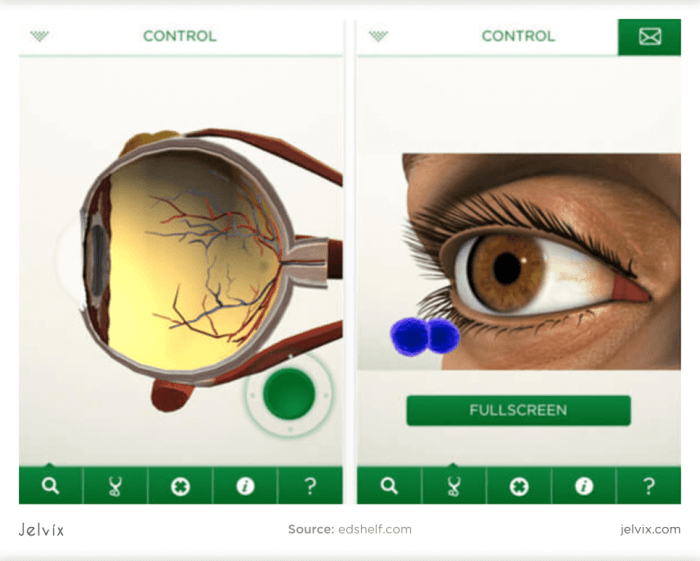
Source: jelvix.com
Augmented reality (AR) in healthcare is rapidly evolving, driven by advancements in computing power, sensor technology, and user interfaces. This evolution promises to reshape the delivery of care, improving patient outcomes and enhancing the overall experience for both patients and healthcare professionals. This section delves into the emerging technologies driving this transformation, future applications, and the anticipated impact on various healthcare sectors.The burgeoning field of AR healthcare is not just about overlaying digital information on the real world; it’s about creating interactive and personalized experiences that can augment existing processes and create entirely new possibilities.
This transformative potential is expected to revolutionize how we approach diagnosis, treatment, and patient support, leading to more efficient and effective healthcare systems.
Emerging Technologies Shaping the Future of AR Healthcare
Several technologies are fueling the development of innovative AR applications in healthcare. These include advancements in display technology, improving the clarity and resolution of overlays, and the development of more intuitive and user-friendly interfaces, making AR tools more accessible to healthcare professionals. Simultaneously, the growth of high-speed, low-latency network connections will facilitate the seamless transmission of complex medical data and AR experiences.
Improved sensor technology, particularly in areas like motion tracking and depth perception, allows for more accurate and responsive interactions within the AR environment.
Future Applications of AR in Healthcare
AR’s potential extends far beyond simple overlays. Current trends suggest that future applications will incorporate personalized patient experiences, tailored to individual needs and medical conditions. For instance, AR could guide surgical procedures with real-time anatomical overlays, enabling surgeons to perform more precise and minimally invasive operations. Additionally, remote patient monitoring, combined with AR-based diagnostic tools, could allow for early detection and intervention in various conditions.
Projected Impact of AR on Healthcare Sectors
The following table Artikels the anticipated impact of AR across key healthcare sectors:
| Healthcare Sector | Projected Impact |
|---|---|
| Surgical Procedures | Enhanced precision, reduced invasiveness, improved surgical outcomes, and faster recovery times. |
| Medical Training | Immersive, interactive simulations that provide realistic practice opportunities, improving skills and knowledge retention. |
| Patient Education | Interactive visualizations of medical conditions and treatments, promoting better patient understanding and engagement. |
| Remote Patient Monitoring | Real-time data collection and analysis, allowing for early detection of potential issues and proactive interventions. |
| Diagnostics | Enhanced diagnostic capabilities, providing clinicians with more accurate and detailed information. |
Hypothetical Future Healthcare Scenario Incorporating AR
Imagine a scenario where a patient with a suspected heart condition is experiencing chest pain. Using a portable AR device, the patient’s physician can access real-time data from various physiological sensors, overlaid on the patient’s chest. The physician can remotely assess the patient’s condition, identifying anomalies and potentially triggering immediate interventions through remote guidance. This AR-enabled system provides immediate access to expert consultation, even when the patient is in a remote location.
This hypothetical example highlights the potential of AR to improve access to care and facilitate faster, more informed diagnoses.
Specific AR Healthcare Applications
Augmented reality (AR) is rapidly transforming healthcare, offering innovative solutions across various domains. AR’s ability to overlay digital information onto the real world presents significant opportunities to enhance patient care, improve professional efficiency, and streamline workflows. This section delves into specific applications of AR in healthcare, illustrating its impact on surgical procedures, patient education, remote consultations, and diagnostic imaging.
Surgical Planning and Simulation
AR overlays digital models of anatomical structures onto a patient’s actual body, allowing surgeons to visualize complex procedures in a non-invasive environment. This capability dramatically improves surgical planning and minimizes risks. Surgical simulations, facilitated by AR, allow for practice and refinement of techniques before the actual operation, reducing the learning curve and enhancing surgeon confidence.
- Pre-operative planning: AR facilitates precise visualization of anatomical structures, enabling surgeons to plan complex procedures with enhanced accuracy. This translates to better surgical outcomes and reduced complications.
- Interactive 3D models: AR enables the creation of interactive 3D models of organs and tissues, allowing surgeons to explore different surgical approaches in a virtual environment. This empowers them to make informed decisions about surgical strategies.
- Surgical guidance: AR provides real-time guidance during surgery, overlaying anatomical information directly onto the surgical field. This ensures accuracy and precision during critical steps of the procedure.
Patient Education and Rehabilitation
AR offers engaging and interactive tools for patient education and rehabilitation. By using interactive simulations, AR applications can help patients understand their conditions and treatment plans better.
- Interactive anatomy lessons: AR applications allow patients to explore the human anatomy in an interactive and engaging manner, enhancing their understanding of their medical condition and treatment procedures. For example, a patient undergoing heart surgery can use AR to see detailed models of the heart, blood vessels, and valves, facilitating a better comprehension of the procedure and their role in the recovery process.
- Rehabilitation exercises: AR provides interactive exercises and guidance, making rehabilitation more engaging and motivating. This can include virtual reality environments where patients can practice specific movements or exercises, improving their physical recovery.
- Mental health support: AR can also be used for mental health support by providing virtual environments that can aid in stress reduction, anxiety management, or emotional regulation.
Remote Diagnosis and Consultation
AR can empower healthcare professionals to perform remote diagnoses and consultations, bridging geographical gaps and enhancing accessibility. AR overlays can provide clinicians with real-time data from remote locations, enabling faster diagnoses and treatment decisions.
- Remote examination: AR allows remote examination of patients by overlaying digital data on real-time video feeds. This is particularly useful for specialized consultations, where the specialist can view and interact with the patient’s body and condition remotely.
- Real-time data sharing: AR facilitates the real-time exchange of diagnostic data, such as medical images or patient vitals, between healthcare providers across locations. This facilitates rapid decision-making and collaboration.
- Telemedicine enhancement: AR enhances telemedicine capabilities by providing remote healthcare professionals with real-time diagnostic support. This can help them to make better-informed decisions, improve patient care, and streamline the diagnosis process.
Medical Imaging and Diagnostics
AR overlays can enhance the interpretation of medical images, facilitating faster and more accurate diagnoses.
- Image overlay and annotation: AR can overlay digital data onto medical images, such as X-rays, CT scans, and MRIs, aiding clinicians in identifying abnormalities and making accurate diagnoses. This allows for a more thorough and precise assessment of the patient’s condition.
- Interactive visualization: AR allows for interactive visualization of medical images, enabling healthcare professionals to rotate, zoom, and manipulate the images for a comprehensive understanding of the patient’s condition.
- Enhanced diagnostic accuracy: AR applications can be used to create 3D models from medical images, helping to enhance diagnostic accuracy and improve the understanding of complex anatomical structures and abnormalities. This is particularly valuable in cases involving intricate or complex structures.
Illustrative Examples of AR in Healthcare
Augmented reality (AR) is rapidly transforming healthcare, offering innovative solutions across various domains. This section presents specific examples of AR applications in surgery, patient education, remote monitoring, and medical training, demonstrating the practical impact of this technology.
AR Application in Surgery
AR overlays digital information onto the surgeon’s view of the surgical field. This augmentation can significantly enhance surgical precision and efficiency. A prime example involves AR-guided surgical procedures, where 3D models of anatomical structures are superimposed onto the real-time view of the patient. This allows surgeons to visualize complex anatomical relationships, identify critical structures, and perform procedures with greater accuracy and reduced invasiveness.
For instance, AR can be utilized in neurosurgery to precisely guide the placement of instruments during procedures, minimizing risks associated with delicate anatomical structures. The system could display detailed 3D models of the patient’s brain, overlaid onto the live surgical view, enabling surgeons to navigate complex pathways with enhanced visibility.
AR-Based Patient Education Program
AR applications provide interactive and engaging learning experiences for patients. A patient education program using AR could present 3D models of anatomical structures or explain medical procedures in a dynamic and intuitive manner. For example, patients undergoing cardiac procedures could use an AR app to visualize the heart’s anatomy, understand the procedure’s steps, and anticipate post-operative recovery. Interactive exercises and quizzes integrated into the AR program would further reinforce learning and comprehension.
AR-Based Remote Monitoring System
Remote patient monitoring (RPM) is crucial for managing chronic conditions and improving patient outcomes. AR can be a key component in such systems. A hypothetical AR-based RPM system would provide real-time monitoring and personalized insights.
| Key Feature | Benefit |
|---|---|
| Real-time physiological data visualization | Provides instant updates on vital signs, allowing for proactive intervention. |
| AR overlays for personalized insights | Transforms data into actionable information for both patients and healthcare professionals. |
| Interactive dashboards for patient and caregiver engagement | Empowers patients and caregivers with clear, accessible information. |
| Integration with existing EMR systems | Streamlines data flow and ensures seamless information sharing. |
| Automated alerts and notifications | Prompts timely interventions for critical situations. |
AR for Medical Training and Education
AR offers immersive learning experiences for medical students and professionals. Training scenarios can be simulated using AR to allow practitioners to practice complex procedures in a risk-free environment. For example, medical students could use AR to virtually dissect anatomical structures, practice surgical techniques, and learn about the intricacies of medical devices. The AR environment can be customized to provide different levels of difficulty, allowing learners to gradually progress from basic to advanced skills.
Furthermore, AR can provide immediate feedback and guidance during training, enhancing the learning experience.
Final Thoughts
In conclusion, the impact of augmented reality on healthcare is profound and multifaceted. From enhancing patient engagement to improving operational efficiency, AR holds immense promise for revolutionizing the way we deliver and experience healthcare. While ethical considerations and challenges must be addressed, the potential benefits of this technology are undeniable, paving the way for a more personalized, efficient, and effective healthcare system.
Future innovations in AR will undoubtedly shape the future of healthcare, offering new possibilities for improving lives.
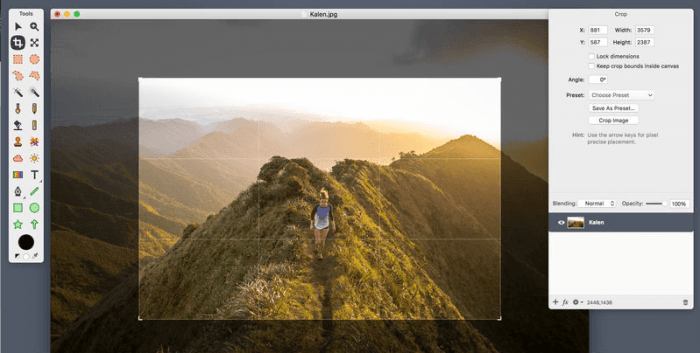
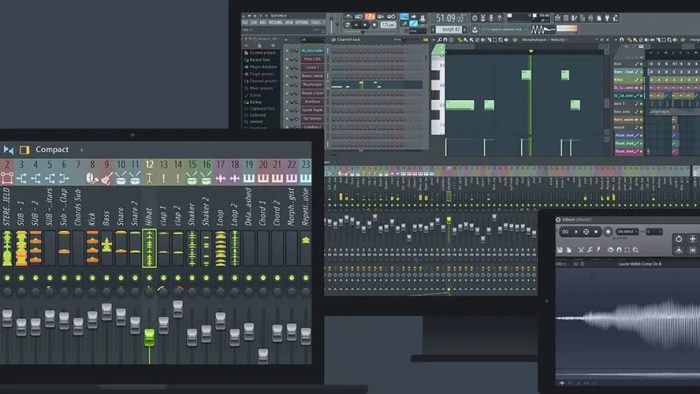

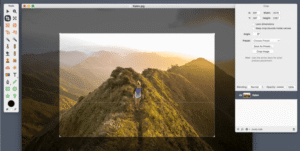









Post Comment